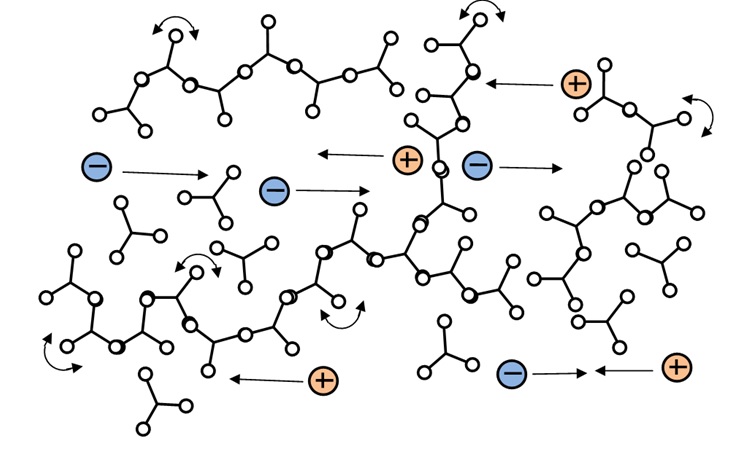DEA라고도 알려진 Dielectric cure monitoring은 polymer의 resistivity와 permittivity를 측정하며, 이것은 열경화성 재료의 유전체 특성입니다. 일반적으로 resistivity는 복합적인 경화 상태에 대한 가장 유용한 정보를 제공합니다. resistivity는 mobile ion의 흐름으로 인한 주파수 독립적인 요소와 stationary dipole의 rotation의 주파수 의존적인 요소를 가지고 있습니다.
ion viscosity(IV)라는 용어는 1980년대 초에 주파수에 독립적인 resistivity의 동의어로 만들어졌습니다. 왜일까요? 주파수에 독립적인 resistivity는 ionic mobility에 의해 결정이 되고 재료의 polymer chain이나 결합의 상태는 ionic mobility와 흐름에 대한 mechanical resistance 모두에 영향을 미치기 때문입니다. 따라서 ion viscosity는 흔히 mechanical viscosity와 scaling factor만 다르며 에폭시, 폴리우레탄, 폴리스티렌, bulk molding compounds(BMC), sheet molding compound(SMC) 및 기타 열경화성 재료 관찰에 유용한 매개변수입니다.

열경화성 재료 또는 복합적인 경화 진행 중에 ion viscosity는 보통 gelation 이전의 mechanical viscosity에 비례하고 gelation 이후에는 modulus에 비례합니다. 결과적으로 ion viscosity는 전체적인 경화 거동에 대하여 해석이 가능하게 하는 유용한 매개변수이며 ion viscosity 특성곡선의 각 임계점은 경화 과정의 특성을 파악할 수 있도록 합니다.
ion viscosity와 mechnical viscosity의 관계는 복합적인 경화 거동 모니터링의 기초가 됩니다. 예를 들어, 재료의 viscosity가 최소치에 도달했을 때를 안다면 laminate나 molded part를 압축하기 위한 최적의 압력을 적용할 수 있습니다. 심지어 ion viscosity가 mechanical viscosity에 벗어난 후에도 ion viscosity는 지속적으로 재료의 상태를 나타내고 사용자가 정의한 열경화성 재료나 복합적인 경화의 종료 시점을 나타낼 수 있습니다.
Dielectric cure monitoring, also known as DEA, measures a polymer’s resistivity and permittivity, which are the thermoset’s dielectric properties. In general, resistivity provides the most useful information about composite cure state. Resistivity itself has a frequency independent component due to the flow of mobile ions and a frequency dependent component due to the rotation of stationary dipoles.
The term ion viscosity (IV) was coined in the early 1980’s as a synonym for frequency independent resistivity. Why? Because frequency independent resistivity is determined by ionic mobility, and the state of a material’s polymer chains or networks affects both ionic mobility and mechanical resistance to flow. Consequently, ion viscosity often differs from mechanical viscosity by only a scaling factor and is a useful probe of the cure state of epoxies, polyurethanes, polystyrenes, bulk molding compounds (BMC), sheet molding compounds (SMC) and other thermosets.
During thermoset or composite cure, ion viscosity is often proportional to mechanical viscosity before the gel point and proportional to modulus afterward. Consequently, ion viscosity is a useful probe of material state through the entire cure and Critical Points on the ion viscosity curve can characterize the progress of cure.
The relationship between ion viscosity and mechanical viscosity is the basis of composite cure monitoring. Knowing when a material has reached the viscosity minimum, for example, allows optimum application of pressure to compress a laminate or a molded part. Even after ion viscosity diverges from mechanical viscosity, ion viscosity continues to indicate material state and can indicate a user defined end of thermoset or composite cure.
Reference :
Lambient TechnologiesTM Technical Overview 3.03—Ion Viscosity in Thermoset and Composite Cure Monitoring, Page 2
상세한 사항은 아래 첨부된 자료를 참고 부탁 드립니다.
